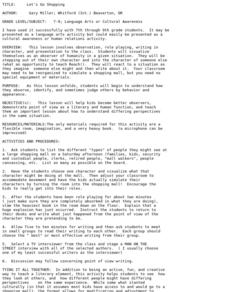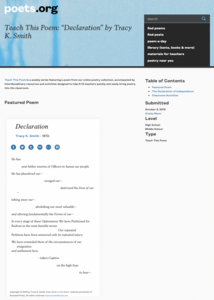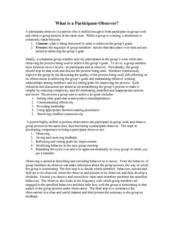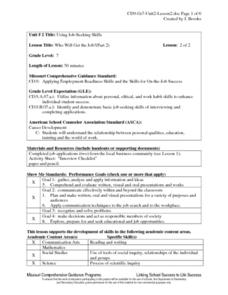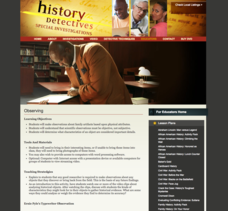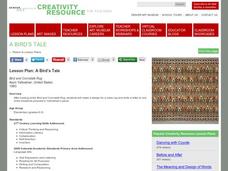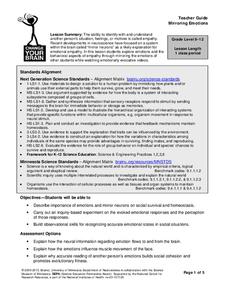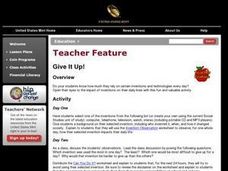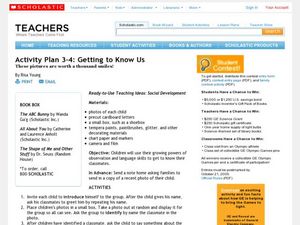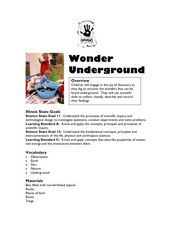American Psychological Association
Counting Fidgets: Teaching the Complexity of Naturalistic Observation
Why do psychologists conduct experiments in controlled laboratory settings? High schoolers gain an understanding of the importance of controls with an activity that involves naturalistic observations with no imposed controls.
Curated OER
What Can We Learn From the Past?
What would future archeologists learn from your scholars' personal belongings? Have them bring in a box of "primary sources" from their home. Discuss the difference between observations and inference, using some of your own items to...
Curated OER
Lesson: A Picture is Worth a Thousand Words: Attention to Detail
After a quick warm up activity, learners get ready to use their keen observation skills to examine an ornate Japanese pencil box. They discuss the artistry, skills, and story of the box, paying close attention to details. They then...
Curated OER
Memories to Last: Observing Monuments
Students use scientific observation and inference to examine the Hazen Brigade Monument. In this observation lesson, students review the reasons for building monuments in society. Students then recall monuments they have seen and...
Curated OER
Observing Weather
Students investigate the weather by reading children stories. In this weather observation lesson, students read Cloudy With a Chance of Meatballs and several other stories about weather before they create a KWL chart....
Curated OER
Transparent Shoebox Dig
Take this simulated archaeological dig one layer at a time with your young pupils to encourage observation, critical thinking, and careful attention. Using a transparent box full of layers of sand and artifacts, pupils examine the...
Curated OER
Holidays and Observances: Looking at Diversity and Culture
Students share their own knowledge and experiences of holidays they observe. They research a holiday of their choice and write a report. They also create art of their holiday to complete as a pre-writing activity.
Curated OER
Let's Go Shopping
Students explore how to become better observers, demonstrate point of view as a literary and human function, and learn an important lesson plan about how to explain differing perspectives in the same situation.
US Institute of Peace
Observing Conflict
Can your class manage conflict? Give them the tools they need to succeed at conflict resolution with the third lesson in a 15-part series of peacebuilding activities. Learners draw from personal conflict experience as they analyze...
Academy of American Poets
Teach This Poem: “Declaration” by Tracy K. Smith
Tracy K. Smith's erasure poem "Declaration" challenges scholars to use their noticing skills to make connections between an engraving entitled "The Declaration of Independence" and Smith's poem. Class members record observations and...
Benjamin Franklin Tercentenary
Let’s Throw an Electric Science Party!
Are you looking for a shockingly good lesson? Check out one that has middle schoolers recreate four of Benjamin Franklin's experiments. Groups investigate, observe, and draw conclusions about static electricity and electrical current....
Curated OER
Participant-Observer Guidelines Handout
Take your collaborative group work to a higher level with this informative handout about the nature, aims, and tasks of participant-observers. Teaching middle and high schoolers how to improve group process advances collaboration skills...
Curated OER
Who Will Get the Job?
Seventh graders demonstrate their ability to identify interview skills that lead to success in the job-seeking process by participating in and observing an interview with an employer. Students also use a checklist to validate their...
Stanford University
Observing Human Rights Day
How much intervention is appropriate for America to take in cases of human rights violations? Class members ponder a question that has lingered since the birth of America with a series of primary sources that reflect the degree to which...
PBS
Observation
Students study making scientific observations . They conduct a "field study" in their attic and make observations about their family artifacts based upon physical attributes. In addition, they determine what characteristics of an object...
Curated OER
Observing the Sky
Students explore astronomy. For this astronomy lesson, students discuss the history of the movement of celestial bodies and then communicate with other students regarding the movements that they observe in the sky nightly. Students...
Curated OER
Lesson Plan: A Bird's Tale
Who wouldn't love to get a letter from a blue bird? Elementary art enthusiasts analyze the social and historical context of Ason Yellowhair's Navajo piece, Bird and Cornstalk Rug. They examine the construction and images on the rug...
University of Minnesota
Mirroring Emotions
Do you ever give your class the "teacher look"? Without saying a word, they become silent and engaged (hopefully). How do they know what you're thinking? Explore the concept of nonverbal communication and how it relates to our...
Curated OER
Observing Sea Ice
Students study and observe types of sea ice found in Alaska. In this sea ice lesson, students use the student network for observing weather to study the different types of sea ice. Students study sea ice depicted in Alaskan art.
Curated OER
Artifact Identification-What is it?
Students observe an artifact and make an inference about the artifact's purpose. They are going to role-play as archaeologists by using artifacts to hypothesize about the lives of past people.
Curated OER
Inventions and How They Impact Our World
Students select an invention from a list, observe the invention for one whole day to determine how their selected invention impacts their daily life. They share their observations as a class and describe their experiences.
Curated OER
Getting to Know Us
Young scholars discover pictures are worth a thousand smiles. In this early childhood language arts lesson, students use their growing powers of observation and language skills to get to know their classmates.
Curated OER
Wonder Underground
Students classify and record objects they find "underground." In this observation instructional activity, students dig into bins filled with soil and encounter various objects such as bark, twigs, etc. Students classify their findings.
Curated OER
Creeping and Crawling Observing Mealworms and Earthworms
Fifth graders observe mealworms and earthworms. In this mealworm and earthworm lesson, 5th graders complete an experiment in which they observe the life cycle and living conditions of mealworms and earthworms. They experiment with...
Other popular searches
- Observe Physical Properties
- Observe the Night Sky
- Scientific Process Observe
- Predict Observe Explain
- Observe Stomata
- Observe and Infer
- 5 Senses to Observe
- Observe and Classify
- Fire Drill Observe
- Observe Fungus
- Cooperative Observer Network
- Observed Change







